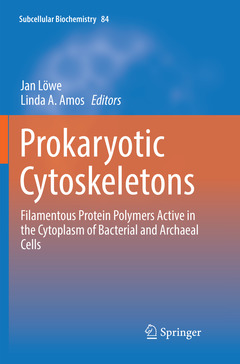Description
Prokaryotic Cytoskeletons, Softcover reprint of the original 1st ed. 2017
Filamentous Protein Polymers Active in the Cytoplasm of Bacterial and Archaeal Cells
Subcellular Biochemistry Series, Vol. 84
Language: English
Subjects for Prokaryotic Cytoskeletons:
Publication date: 08-2018
Support: Print on demand
Publication date: 05-2017
Support: Print on demand
Description
/li>Contents
/li>Comment
/li>
This book describes the structures and functions of active protein filaments, found in bacteria and archaea, and now known to perform crucial roles in cell division and intra-cellular motility, as well as being essential for controlling cell shape and growth. These roles are possible because the cytoskeletal and cytomotive filaments provide long range order from small subunits. Studies of these filaments are therefore of central importance to understanding prokaryotic cell biology. The wide variation in subunit and polymer structure and its relationship with the range of functions also provide important insights into cell evolution, including the emergence of eukaryotic cells.
Individual chapters, written by leading researchers, review the great advances made in the past 20-25 years, and still ongoing, to discover the architectures, dynamics and roles of filaments found in relevant model organisms. Others describe one of the families of dynamic filaments found in many species. The most common types of filament are deeply related to eukaryotic cytoskeletal proteins, notably actin and tubulin that polymerise and depolymerise under the control of nucleotide hydrolysis. Related systems are found to perform a variety of roles, depending on the organisms. Surprisingly, prokaryotes all lack the molecular motors associated with eukaryotic F-actin and microtubules. Archaea, but not bacteria, also have active filaments related to the eukaryotic ESCRT system. Non-dynamic fibres, including intermediate filament-like structures, are known to occur in some bacteria.. Details of known filament structures are discussed and related to what has been established about their molecular mechanisms, including current controversies. The final chapter covers the use of some of these dynamic filaments in Systems Biology research. The level of information in all chapters is suitable both for active researchers and for advanced students in courses involving bacterial or archaeal physiology, molecular microbiology, structural cell biology, molecular motility or evolution.
Chapter 3 of this book is open access under a CC BY 4.0 license.
Overview of the diverse roles of bacterial and archaeal cytoskeletons.- E. coli cell cycle machinery.- Cell cycle machinery in Bacillus subtilis.- Cytoskeletal proteins in Caulobacter crescentus.- FtsZ constriction force – curved protofilaments bending membranes.- Intermediate filaments supporting cell shape and growth in bacteria.- Z-ring architecture and its control by MinCD co-polymers.- Bacterial actins.- Bacterial nucleoid occlusion.- Structure and dynamics of actin-like cytomotive filaments in plasmid segregation.- Tubulin-like proteins in prokaryotic DNA positioning.- The structure, function and roles of the archaeal ESCRT apparatus.- Archaeal actin-family filament systems.- The tubulin superfamily in archaea.- Reconstitution of protein dynamics involved in bacterial cell division.
Is the first book to bring together a wide range of expert opinion in this new highly-active field
Focusses on supramolecular structure and function: filaments working as intracellular machines
Provides high quality color figures to support the text

